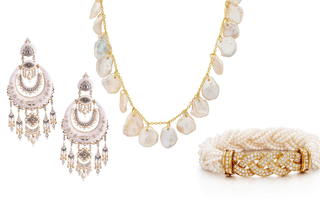Seed pearls have long been a favourite choice for intricate designs throughout jewellery history, whilst the baroque forms of keshi pearls are today featured to bring jewellery design a touch of uniquity.
|
|
Seed pearl is the term given to both salt and freshwater pearls smaller than 3mm. By World Jewellery Foundation (CIBJO) definition, these pearls are of natural origin only, produced without human intervention.
Seed pearls have been a popular choice through time as smaller size pearls allow for intricate detailing and easier incorporation into a design than larger, statement pearls.
During the neoclassic period of 1800 – 1820, bunches of grapes and currants were represented in jewellery design by use of seed pearls. In the early Victorian period spanning 1837 – 1860, the trend of the time was to thread seed pearls backed with mother-of-pearl onto white horsehair, creating parures of elaborate designs.
By the art deco period of 1920 – 1930, the use of seed pearls had evolved to include adorning lavish evening bags along with emeralds, rubies, and other precious gemstones.
Unlike seed pearls, keshi pearls can be of any size, depending on the oyster or mollusc in which they grow. Akoya keshi pearls tend to be 2mm or less, whilst south sea and tahitian keshi pearls are generally 4mm+, even reaching impressive sizes over 10mm.
Originally keshi, meaning ‘poppy’, was a trade designated term in Japan referring to small pearls, either naturally forming in saltwater or cultured without a bead, with a baroque shape.
In more recent times, the term keshi pearls encompasses non-beaded pearls that develop either accidentally or intentionally as a by-product of the pearl culturing process, such as when the mantle rim of the oyster is damaged, or when part or the whole of the inserted mantle tissue creates a pearl sac when the bead is rejected. This means keshi pearls may be south sea, tahitian, akoya, cultured freshwater, or natural.
Under the CIBJO pearl guidelines, it is noted the term keshi is often misused, and specified that the formation origin as either ‘natural’ or ‘cultured’ should always be included alongside keshi when describing them.
Since the growth of keshis may occur accidentally without human intention, and they consist of only natural material (the layers of nacre), there is much debate and differing opinion as to whether keshi pearls should be classified as natural. The difficult factor is distinguishing whether the cause of growth was truly accidental or intentionally inflicted.
Regardless, being the only saltwater cultured pearl without a nucleus inserted by man, the keshi pearl has gained an appreciation of its own.
Given the lack of a uniform bead and often unintentional nature of keshi growth, these pearls are baroque, occurring in a wide and interesting range of shapes that offers jewellery a sense of uniqueness and intriguing design.
Occurring in every type of pearl oyster, keshi pearls come in every possible colour of pearl – from the cream and silvery whites of akoya and south sea pearls, to the cool colours of tahitian pearls. They may even be what looks
like two pearls conjoined - each a different colour.
Taking advantage of the truly inimitable shapes and the exceptional lustre resulting from all-nacre pearls, keshis are both growing in popularity amongst consumers and appreciation amongst jewellers as an inspiring addition to jewellery design.
Posted July 01, 2022 |

